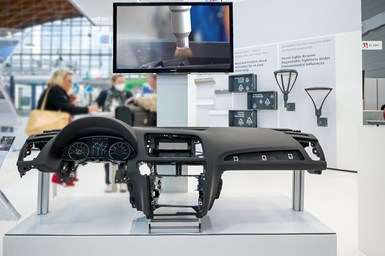Plasmatreat Openair-Plasma offers safe surface cleaning, activation
The atmospheric plasma solutions include high-efficiency plasma cleaning, activation and nanocoating of surfaces.
Even large components, such as an automotive dashboard, can emerge from the 3D printer and then be bonded, painted or printed — all possible through pretreatment with Openair-Plasma. Photo Credit: Plasmatreat
Plasmatreat’s (Steinhagen, Germany) Openair-Plasma processes are designed to optimize additive manufacturing (AM) by significantly improving the quality of components while also reducing the manufacturing company’s carbon footprint. The company says atmospheric pressure plasma pretreatment is one of the most efficient plasma processes for cleaning, activating or coating plastics, metals, glass, recycled materials and composite materials (see “Atmospheric plasma jet technology rapidly pretreats glass fiber honeycomb sandwich panels” for an example).
Activating the surface with Openair-Plasma enables environmentally friendly printing and painting without resorting to conventional flame treatment or chemical pretreatment. In comparison to low-pressure plasma technology, no special chamber system is required when Openair-Plasma technology is used. During ultrafine cleaning with Openair-Plasma (plasma cleaning), surfaces are gently and safely cleaned of release agents and additives, and sterilized (plasma sterilization), while plasma activation makes later adhesion of glues and coatings possible. By using the nanocoating PlasmaPlus (plasma coating), functionalized surface characteristics can also be produced that meet special product requirements.
The Openair-Plasma process is a simple, safe and environmentally friendly technology — only air, electrical power and the existing production line are required for plasma treatment under normal pressure. As a result, Openair-Plasma can be used in almost all areas of industrial manufacturing.
The long-term durability of inks and coatings can also be further increased by a supplementary PlasmaPlus coating. When bonding products from the 3D printer, the use of plasma technology also replaces the use of chemical adhesion promoters (primers) and achieves long-term stable bonds — even when originally incompatible materials are used. Users thus benefit from an expanded choice of materials.
The process is known for reliability and cost-effectiveness. High process speed and lower scrap rates provide high process efficiency. Because it enables flexible material selection, the Openair process also facilitates the use of more advantageous materials.
It also offers a high degree of activation. Unlike corona treatment, Openair-Plasma permits a high degree of activation of the surfaces to be treated. Additionally, it provides a large process window as the danger of thermal component damage is extremely low in comparison to flaming.
The process is alo easy to integrate. In contrast to mechanical processes, like roughening and sand or aluminum oxide blasting, Openair-Plasma can easily be integrated inline in existing processes.
The process is also environmentally friendly as it makes it possible to treat surfaces with solvent-free and VOC-free methods. Unlike electrochemical processes, such as galvanizing or galvanically-supported pickling and chrome plating, wet chemistry is not required.














.jpg;maxWidth=300;quality=90)


